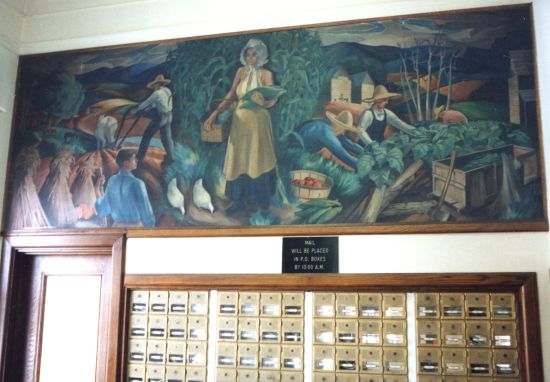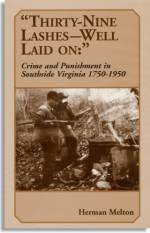
“Perfectly decorative” is the phrase artist Carson Davenport used to defend his use of the dominant figure of a farm woman and other items against the criticism of his mural by a supervisor.
Davenport's 12 foot by 4 1/2 foot oil on canvas titled Harvest Season in Southern Virginia has graced the north wall of the Chatham Post Office lobby for 63 years. It has been a source of local pride from the date of its unveiling.
Last year's announcement that the U.S. Postal Service was planning to erect a new post office at another location in Chatham sparked apprehension among locals concerning the future of the valuable mural. Many of them became concerned about its safety.
Could the mural be moved to the new location? Was it permanently a part of the wall? How valuable is it? Was it a WPA painting? Is there an recorded history of the mural in Pittsylvania Historical Society files?
Native Pittsylvanians remember the existence of a brief history of it that normally hung in a bulletin board in the lobby. This has long since disappeared.
This writer was asked by Randy Alderson, Chatham's genial postmaster, if it would be possible to acquire some background information on the painting so that post office personally could address questions from concerned citizens.
Since the information requested was historically very important, the writer agreed to perform some research on the subject. The following is the product of that immensely interesting and rewarding task.
When Davenport's sketch of his proposed mural was rejected by his Washington, D.C., supervisors in early 1938, he fought against the required revisions. With consummate skill, he ultimately managed to salvage enough of his original design to maintain most of the integrity he coveted.
Chatham's mural is one of 1,400 produced by 850 “New Deal” artists during the Great Depression.
It is commonly believed locally that this mural was a product of the WPA Federal Art Project. Not so. Whereas that program was in progress at the time, Harvest Season in Southern Virginia was completed under the auspices of the U.S. Treasury Department's Section of Fine Arts.
It was the responsibility of that organization to decorate the new post offices being constructed by Franklin D. Roosevelt's New Deal during the Depression.
Fortunately, Chatham was one of 1,100 localities chosen by the New Deal to recieve a new public works post office. The cornerstone for this one was set in 1935.
There are some unique and interesting aspects of the mural. For example, few local citizens remember that it was painted in Florida. That was because the artist was one of 10 who received a grant to work there under favorable conditions at the Ringling School of Art during the winter of 1938.
This school was founded by the owners of the famous circus and that adds a unique interest to the work.
The artist may have been the recipient of this grant because his art depicting rural life in America came to the attention of Mrs. Franklin D. Roosevelt. She had requested earlier that one of his paintings be hung in the White House — a signal honor.
The mural fulfilled the requirements of the Treasury Department's Fine Arts Section which dictated that a piece of art reflect either the culture, the economy, or the history of the locality.
In the mural, Davenport emphasizes tobacco, Pittsylvania County's major crop, along with corn and melons in the harvest scene. It is known that this artist on occasion departed from realism in order to experiment with various styles of expression. This may explain the difference in scale and proportion of some of the figures.
The mural was generally favorably received in Pittsylvania County after it was mounted and unveiled on Saturday, July 23, 1938. However, there was some local criticism of the rich green color of the tobacco leaves, which at harvest time normally adopt autumn hues of yellow and brown.
A word about this rather remarkable artist is in order. Carson Davenport was born in Danville in 1908 and first studied art at Stratford College and later at the Corcoran School of Art in Washington, D.C. He also studied at the Grand Central School of Art in New York and at the Ringling School of Art in Florida.
Davenport's work in the federal art project during the Depression brought him considerable acclaim, and, as mentioned, one of his works was hung in the White House.
In 1937 he was appointed director of the WPA Art School and Gallery at Big Stone Gap. His crowning achievements came when his art was selected for exhibition at the New York World's Fair in 1939.
The artist painted two other post office murals in Greensborough, Ga., in 1939. One is a harvest scene titled Cotton Picking in Georgia. The other depicted a Native American massacre and was titled The Burning of Greensborough.
Eventually, he opened a gallery in Danville and was later reappointed chairman of the Averett College Art Department. He is recognized as an artist with a fascination for the sea and his deep identification with the working class of America is apparent in many of his works in both water color and oil.
Two studied opinions were derived from this research on the work of Carson Davenport:
In this setting, he was in stiff competition with hundreds of immensely talented but struggling young artists. Among them was the great Peter Hurd (who was to become a colleague and relative of Andrew Wyeth), Bernard Arnest, Henry Varnum Poor and Boardman Robinson.
To emerge with three commissions for post office murals amidst such competition is in itself an enormous achievement.
In a letter to the Treasury Department after the unveiling of the mural in 1938, Chatham postmaster Judson Patterson summed up briefly, but succinctly, the feelings of Chathamites: “We think it is a beautiful piece of work and all the citizens of our town are proud of it.”
They are indeed fortunate to have been blessed with a Davenport mural.

Pittsylvania's Eighteenth-Century Grist Mills

Pittsylvania's Nineteenth-Century Grist Mills

Thirty-Nine Lashes, Well Laid On

Pittsylvania County's Historic Courthouse

Clement: History of Pittsylvania County

Fitzgerald: Pittsylvania: Homes and People of the Past

Hurt: Eighteenth Century Landmarks of Pittsylvania County

Hurt: An Intimate History of the American Revolution in Pittsylvania County

Dodson: Footprints from the Old Survey Books

Byrd: Histories of the Dividing Line Betwixt Virginia and North Carolina

Jones: Tales About People in a Small Town
This website and its ChathamGuide.com portal are sponsored by Mitchells Publications.
Copyright © 2001–2011 Herman E. Melton.